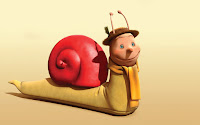Henri Matisse: L'Escargot (1953)
Gouache on paper, cut and pasted on paper
mounted on canvas
Gouache on paper, cut and pasted on paper
mounted on canvas
The Little Greek hates snails, because they eat her plants. But I like them ...
Perhaps it's because I grew up watching The Magic Roundabout and had a particular fondness for Brian. But it's also because, like other molluscs, they seem to me to be fascinating creatures, gastropodding about in the dampness of the garden and leaving a silvery slipstream of mucus in their wake, an ephemeral trail that points the way for the beaks of birds that love to eat them.
Perhaps it's because I grew up watching The Magic Roundabout and had a particular fondness for Brian. But it's also because, like other molluscs, they seem to me to be fascinating creatures, gastropodding about in the dampness of the garden and leaving a silvery slipstream of mucus in their wake, an ephemeral trail that points the way for the beaks of birds that love to eat them.
The fact that snails have little tentacles on their head, a primitive little brain, and possess both male and female sex organs (i.e., are hermaphrodites), also inclines me to view them favourably; they are both alien and perverse when considered from a human perspective.
I particularly like the tiny baby snails, newly hatched, with a small and delicate shell already in place to conceal their nakedness. They are very pretty and very sweet. Francis Ponge speaks of their immaculate clamminess. The fact that people can kill them with poison pellets without any qualms is astonishing and profoundly upsetting to me.
To her credit, the Little Greek only tries to dissuade the snails from eating her plants by using (mostly ineffective) organic solutions, such as coffee granules and bits of broken eggshell sprinkled around. Alternatively, she sometimes rounds 'em up and relocates the snails to the local woods - though this enforced transportation of snails also makes me a little uneasy, as it's all-too-easy to imagine little yellow stars painted on their backs.
Not that this prevents me from eating them, prepared with a garlic and parsley butter when in France, or cooked in a spicy sauce when in Spain ...
Note: the Francis Ponge poem to which I refer and from which I quote is 'Snails', trans. by Joshua Corey and Jean-Luc Garneau, Poetry, (July/August, 2016). Click here to read in full on the Poetry Foundation website.

























